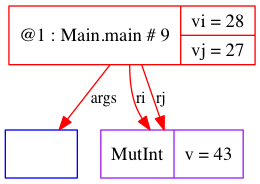


| SE450: Basics: Values and References [34/63] |    |
Java has a reference model for objects. This is like C# are different from C++. In C# terminology, Java objects are boxed, whereas base values are unboxed.
What does the following print?
file:Main.java [source] [doc-public] [doc-private]
01
02
03
04
05
06
07
08
09
10
11
12
13
14
15
16
17
18
19
20



Consider the object diagram after line 00007:
+--------------+ +-----------------+
| i0 : MutInt | | 0 : Main.main |
| ------------ | | ------------- |
+--------------+ +-----------------+
| v:int = 42 | | vi:int = 27 |
+--------------+ | vj:int = 27 |
| ri:MutInt = i0 |
| rj:MutInt = i0 |
+-----------------+
This phenomenon is called aliasing.
Note that aliasing occurs whenever an object is passed as an argument to a function.
Aliasing mutable values must be handled with care.